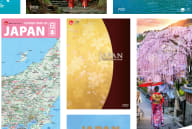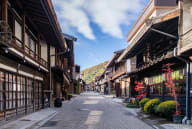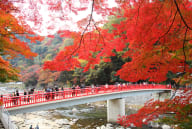
Gifu Discover the flavours of rich heritage
A Culinary Journey in Gifu
Gifu Prefecture, nestled in the heart of Japan, is a region where tradition and nature harmoniously blend to create a culinary paradise. Surrounded by majestic mountains and clear streams, Gifu cultivates crops and specialty products that harmonize perfectly with its unique topography and climate.
Gifu is renowned for its premium Hida beef, a type of wagyu known for its marbled texture and rich, buttery flavour. Raised in the pristine environments of the Hida area, this beef is a highlight of the local cuisine and is often enjoyed grilled or in hot pots. The prefecture’s fertile lands also produce high-quality vegetables and fruits, including the sweet and juicy Fuyu persimmons.
Gifu’s culinary offerings extend to its traditional dishes, such as Ayu (sweetfish) from the clear waters of the Nagara River, which is often grilled with salt to bring out its natural sweetness. The region is also famous for its soba noodles, made from locally grown buckwheat and enjoyed for their nutty flavour and firm texture.
From the luxurious taste of Hida beef to the simple pleasure of fresh, grilled Ayu, Gifu invites you to savour the authentic flavours of its rich heritage and stunning natural surroundings.
Ayu-no-shioyaki (Grilled sweetfish with salt)

What it is (ingredients)
Grilled sweetfish with salt, “Ayu-no-shioyaki” in Japanese, is a delicacy hailing from Gifu. These freshwater fish are seasoned simply with salt before being grilled over charcoal, allowing their natural sweetness and tender flesh to shine. The preparation emphasizes freshness, with the fish often served whole to preserve its delicate texture and subtle taste.
History/Origin
The Nagara River, flowing through Gifu Prefecture, stands as one of Japan's three major pristine rivers, cherished for its unpolluted waters that sustain a rich ecosystem. Sweetfish, Ayu, symbolizing purity, have been nurtured here since ancient times. Cormorant fishing, a tradition spanning 1,300 years, remains a popular tourist attraction, where ayu caught during these events are ceremoniously offered to the imperial family and Ise-jingu shrine. The ayu from the crystal-clear Nagara River holds deep significance in the region's history and culinary traditions, recognized as a Global Agricultural Heritage Site since December 2015.
Where to Eat
Grilled sweetfish with salt can be savoured at traditional Japanese restaurants, Ryokan (Japanese inns) and riverside eateries throughout Gifu prefecture. In Gifu, the traditional fishing technique known as "Yana" involves creating a temporary dam in the river using wooden stakes or bamboo, allowing for the capture of river fish. This method is particularly popular during the sweetfish season from late June to early October. Visitors can participate in "Yana fishing," using their hands to catch sweetfish and enjoy freshly caught delicacies right by the river. Various locations across the prefecture, such as Miyama Kanko Yana and Itadori River Horodo Hachiman Yana, attract families and groups of friends during this season. Additionally, there are riverside bars open until nightfall, where patrons can relax with a drink while listening to the soothing sounds of the river, offering a unique experience for adults.
When to Eat
Ayu-no-shioyaki is best enjoyed during the summer months, when sweetfish are at their peak flavour.
Savour the simplicity and freshness of grilled sweetfish with salt in Gifu, where each bite connects you to the region's natural bounty and cultural heritage.
Hida beef

What it is
Hida beef, renowned for its exceptional marbling and tender texture, is a premium wagyu delicacy from Gifu. Raised with meticulous care in the Hida area, this beef is known for its rich, buttery flavour and melt-in-your-mouth quality. It comes from Japanese Black cattle, known as "Kuroge Washu," and is prized for its high marbling, which contributes to its unmatched juiciness and flavour.
History/Origin
The history of Hida beef dates back about a century when cattle were first introduced to the Hida region. Over time, local farmers refined breeding techniques to enhance the quality of the beef, focusing on marbling and flavour. Hida beef gained national recognition in the 1980s for its exceptional quality, leading to its designation as one of Japan's top-tier beef brands. Today, Hida beef is celebrated as a symbol of Gifu's culinary excellence and is sought after by gourmets worldwide.
Where to Eat
You can enjoy Hida beef at upscale restaurants, Ryokan (Japanese inns), and specialty beef shops throughout Gifu prefecture. These establishments take pride in showcasing the best cuts of Hida beef, often offering it as steak, sukiyaki, or shabu-shabu. Each dining experience highlights the beef's exquisite marbling and flavour, providing a taste of Gifu's gourmet heritage.
When to Eat
Hida beef is available year-round, but it reaches its peak quality in winter when the cows accumulate fat to withstand the cold, resulting in exquisite marbling and rich, fatty beef. It's always a preferred choice for special occasions and indulgent dining experiences.
Savour the exceptional quality and flavour of meticulously raised Hida beef in Gifu.
Kuri-kinton (Sweet chestnut paste confection)

What it is (ingredients)
Kuri-kinton is a traditional Japanese sweet made from chestnuts and sugar, originating from Nakatsugawa City. The main ingredient is boiled and mashed chestnuts, and the paste is sweetened with sugar and squeezed with a tea towel to form it into the shape of a chestnut. The thick, velvety paste captures the essence of fall with its deep nutty flavor and smooth texture.
History/Origin
Nakatsugawa City is said to be the birthplace of Kuri-kinton and is one of the leading chestnut-producing areas in the prefecture. During the Edo period (1603-1868,) Nakatsugawa City was an important post town connecting Edo, Kyoto, and Osaka, via the Nakasendo road. As tea culture developed, Kuri-kinton also spread as a tea sweet, becoming beloved by people all over the country.
Where to Eat
Kuri-kinton can be enjoyed at long-established sweet shops and confectionery stores throughout Gifu Prefecture, especially in Nakatsugawa City. These shops often make their fillings using locally grown chestnuts and traditional methods, ensuring an authentic taste. Kuri-kinton is also served at teahouses, where its sweetness perfectly balances the bitterness of the tea.
When to Eat
Kuri-kinton is especially popular during the autumn and winter months when chestnuts are in season. It is a staple during New Year festivities, but its delightful taste makes it a treat for any occasion. Enjoying Kuri-kinton with a cup of tea on a crisp autumn day, or as part of a festive meal, adds a touch of tradition and warmth to any gathering.
Enjoy Gifu's Kuri-kinton, with its rich natural sweetness that fills your mouth with a nostalgic taste in every bite.































































